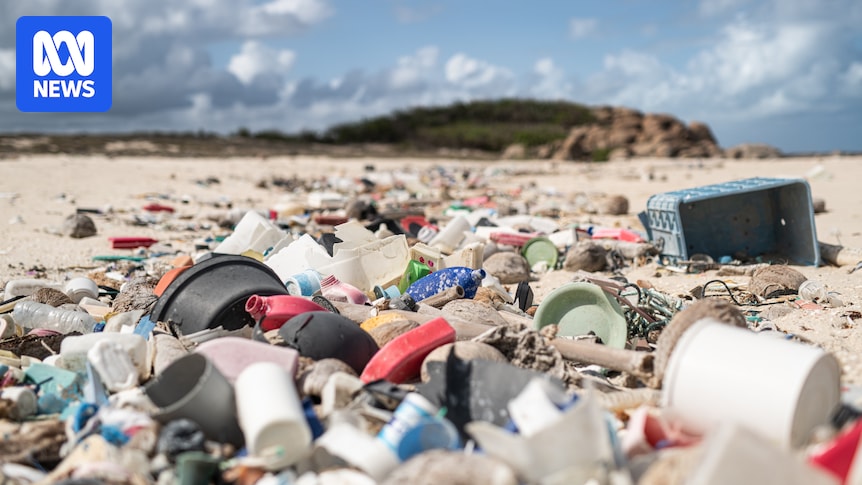On Monday, esteemed British medical journal The Lancet delivered a dire warning, as nations were readying for last-ditch negotiations meant to “end plastic pollution”.
Ahead of a United Nations meeting in Geneva, The Lancet warned plastic — like climate change — had become a “danger” to humanity that was causing disease and death from infancy to old age, to the tune of $US1.5 trillion ($2.3 trillion) a year.
“It is increasingly clear … that plastics pose grave, growing, and under-appreciated dangers to human and planetary health,” the journal reported.
From two megatonnes of plastic produced in 1950, the world is now producing 475 megatonnes a year, and that is expected to triple by 2060.
The Lancet reported 8,000 megatonnes of plastic now pollute the planet, and globally less than a 10th is recycled.
The Lancet has warned that 8,000 megatonnes of plastic now pollutes the environment.
Since 2022, UN member states have been negotiating on a once-in-a-generation “Paris Agreement”-style plan to tackle plastic at every stage of its life cycle, from its creation to eventual disposal.
After negotiations stalled late last year, the UN’s environment assembly set up a final “part two” to negotiations that could potentially require binding caps on plastic production, bans on entire classes of toxic chemicals, and financial mechanisms to support poorer nations to adapt.
At contention is whether the treaty should commit nations to limit plastic production and ban harmful chemicals, or only focus on reducing plastic waste.
With the US fighting limits on plastic, hopes are dimming
With final negotiations underway in Geneva, hope is dimming that the most ambitious parts of the treaty, including caps on plastic production, can be achieved.
In letters circulated to a handful of countries on Monday, first reported by Reuters, the United States urged countries to reject a global pact that would limit plastic production and ban certain plastic chemicals.
It puts the US in direct opposition to more than 100 countries — including Australia — who are pursuing the most ambitious form of a legally binding treaty.
Environment Minister Murray Watt says that Australia is continuing its push for an ambitious treaty to end plastic pollution.
“We are determined to push for an effective and meaningful global treaty to achieve our goal of ending plastic pollution by 2040,” Senator Watt said on Wednesday.
“Solutions are needed across the full life-cycle, including banning problematic plastics and harmful chemicals in plastic, along with preventing leakage to the environment and cleaning up existing pollution.”
Murray Watt says Australia continues to pursue a high ambition binding treaty. (ABC Far North: Bridget Herrmann)
The world’s environment ministers will descend on Geneva next week in hopes of finalising the overdue treaty, though Senator Watt is not on the provisional list of attendees.
While parties have diverged on “upstream” measures to curb production, there are areas of common ground on packaging design and recycling, and the aim remains to achieve something that is binding.
Much like the Paris Agreement to limit global warming to less than 2 degrees Celsius, if a treaty is finalised, a Conference of Parties will then be convened to regularly monitor it, and ensure its implementation.
Without action, plastic production will triple
Plastic production is dominated by a small number of countries.
Just seven countries produce two-thirds of the world’s plastic according to environmental consultancy Eunomia, with the largest being China, the US and Saudi Arabia.
And it is also concentrated in the hands of just a few companies — a quarter of plastic polymers are made by Sinopec, ExxonMobil, LyondellBasell, Saudi Aramco and PetroChina, according to energy data agency Wood Mackenzie.
Minderoo Foundation chief executive John Hartman said there had been a coordinated opposition to the plastics treaty by countries that produce plastic and the petrochemical industry.
“Despite the overwhelming evidence highlighting the dangers, ridding the world of petro-plastics and the toxic chemicals they leach is a challenging process. There are many vested interests in the chemical, fossil fuel and manufacturing industries who are dead set against it,” Mr Hartman said.
“They argue that reducing consumer demand and recycling are sufficient responses to this crisis. This is a fallacy. We cannot recycle our way out.”
In Australia, plastic recycling rates have remained static at about 13 per cent since 2017.
Nations have gathered in Geneva, Switzerland, for a final meeting to negotiate a global plastics treaty. (United Nations Environment Programme, Florian Fusstetter)
Single-use plastics are being phased out, successive governments have committed billions to upgrading recycling facilities and the Albanese government has committed to reforming Australia’s packaging rules, which could see minimum amounts of recycled content required in packaging.
But the government says plastic pollution is a global problem that requires a global solution, and no nation can solve it alone.
Ahead of the treaty’s expected finalisation, The Lancet has launched a global monitoring system on plastics to track progress toward reducing plastic exposure.
It offers a grim starting point.
“The presence of multiple widely used plastic chemicals [have been found] in the bodies of nearly all people examined, including newborn infants and pregnant women. Microplastic and nanoplastic particles are increasingly reported in human biological specimens, including blood, breastmilk, liver, kidney, colon, placenta, lung, spleen, brain, and heart in populations worldwide,” researchers said.
“The world is in a plastics crisis. This crisis has worsened alongside the other planetary threats of our time and is contributing to climate change, pollution, and biodiversity loss.”

